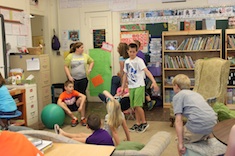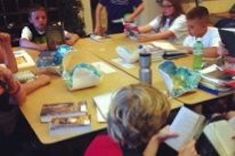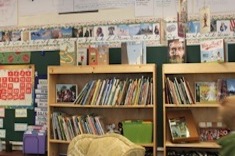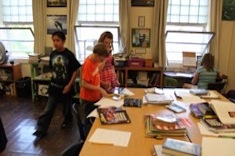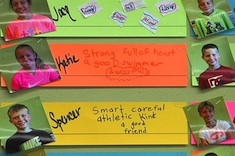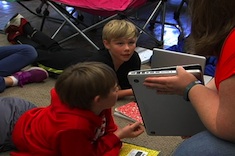A professor in my graduate work in elementary education taught me many years ago to look at the classroom and ask, “Who owns the room?” She cautioned that it was “our” classroom, not “mine.” She suggested that it had never been completely decorated, or “done,” when the school year began, because where was the room for the students? And she reminded us constantly that teacher created or store created, materials could never match student-created materials. She suggested that when you walked into a classroom, you should get a sense immediately of the teacher and students who inhabited it and what was valued. I have remembered her words for 18 years.
This year I can place my finger on the pulse of my students in many parts of our classroom. Here are a few glimpses into how they took charge of it:
The Classroom Library
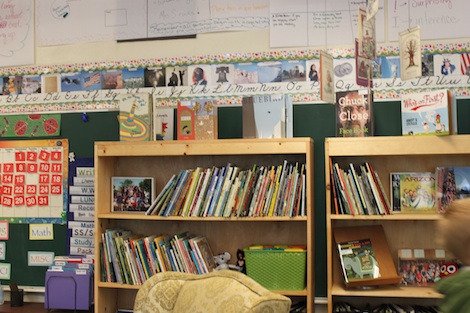 I thrive on organization. Trying to keep our classroom library organized so that almost 80 kids can find the books they need is something I’m constantly thinking about. Sometimes my students come up with new ideas to change our library, and I try to be open minded to them. Our classroom library has gone through many conversions over the years. I wrote before how my students requested that all series books be freed from the genre shelves where they were residing in tubs and be put, spine out, on two shelves devoted only to series books. That was a huge success.
I thrive on organization. Trying to keep our classroom library organized so that almost 80 kids can find the books they need is something I’m constantly thinking about. Sometimes my students come up with new ideas to change our library, and I try to be open minded to them. Our classroom library has gone through many conversions over the years. I wrote before how my students requested that all series books be freed from the genre shelves where they were residing in tubs and be put, spine out, on two shelves devoted only to series books. That was a huge success.
This year, however, my students asked for all books to leave the tubs. My heart beat in horror as I explained the logic behind tubs, that you can flip through the books, that they stay more organized in the library. The students were insistent that we try to go “tub-less” in our classroom. Reluctantly, I agreed. I was certain our 3,000+ book library would become chaos in a matter of days. I was wrong. Not only did the students do a wonderful job putting the books back each day, but books that hadn’t been checked out for more than a year were in the hands of kids. They could see all of the spines at a glance and were more apt to spend time poring over the titles.
Classroom Displays
 I’m not a crafty teacher. I don’t have an artistic bone in my body. As such, I turn over any bulletin board or surface that needs to be decorated to my students. This year we had several displays created by them. Classroom Book-a-Day was an idea that my friend Jillian Heise had last school year. She shared a picture book with her students each day, and they printed off the cover and put it on a table to show the books they read in the year. My students loved the idea, but they wanted to create a sketch for each book we read instead. I turned it over to them. They tweeted out their sketches to authors as we read the books. Author Lauren Castillo asked the student who created the Nana in the City sketch if she could have a copy. At the end of the school year I’d find students looking over our display and reminiscing about the books we’d read together over the year.
I’m not a crafty teacher. I don’t have an artistic bone in my body. As such, I turn over any bulletin board or surface that needs to be decorated to my students. This year we had several displays created by them. Classroom Book-a-Day was an idea that my friend Jillian Heise had last school year. She shared a picture book with her students each day, and they printed off the cover and put it on a table to show the books they read in the year. My students loved the idea, but they wanted to create a sketch for each book we read instead. I turned it over to them. They tweeted out their sketches to authors as we read the books. Author Lauren Castillo asked the student who created the Nana in the City sketch if she could have a copy. At the end of the school year I’d find students looking over our display and reminiscing about the books we’d read together over the year.
We also had a display for Camp Half-Blood from The Lightning Thief. This was a class read-aloud, but the students were entranced by the description of the camp. As I read one day, a boy drew the Poseidon cabin. He asked me if he could put it on the bulletin board. Once I agreed, more cabins joined it. Before long, a group had pored over the text, made a list of the items they could draw that were at camp, and created a sign-up sheet so everyone could participate.
Running the Classroom
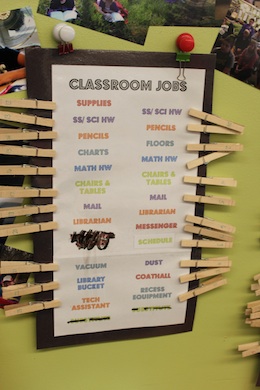 I’ve always had jobs in the classroom. If I’m doing my job correctly, the students don’t need me to get the classroom to run. This is not easy, and I often don’t have faith that they can truly do it. To get a classroom to run smoothly, the students have to buy in to the belief that they are an important part of the classroom. Their jobs are typically things I don’t remember to do on my own. The job chart in our classroom becomes a job in and of itself. The students switch it whenever they decide as a class they are ready to. At the beginning of the school year, they were new to the classroom and tended to keep the same job for weeks. It took time to learn the expectations for each job, and they didn’t need more new information added to their already-full brains. By the end of the year they knew the routines that keep our classroom running. They would switch them every few days so that everyone got to have a “favorite” job again and could get rid of one they didn’t enjoy.
I’ve always had jobs in the classroom. If I’m doing my job correctly, the students don’t need me to get the classroom to run. This is not easy, and I often don’t have faith that they can truly do it. To get a classroom to run smoothly, the students have to buy in to the belief that they are an important part of the classroom. Their jobs are typically things I don’t remember to do on my own. The job chart in our classroom becomes a job in and of itself. The students switch it whenever they decide as a class they are ready to. At the beginning of the school year, they were new to the classroom and tended to keep the same job for weeks. It took time to learn the expectations for each job, and they didn’t need more new information added to their already-full brains. By the end of the year they knew the routines that keep our classroom running. They would switch them every few days so that everyone got to have a “favorite” job again and could get rid of one they didn’t enjoy.
One of the main jobs they all take on is ensuring that the classroom runs if we have a “guest teacher” for the day, otherwise known as a substitute. Early on in the year I lay down my expectations for when a guest teacher is in the building. We talk about how they might be unfamiliar with technology, how the format of our class with a minilesson and work time might be new to them. I explain that it is up to the students to ensure that any guest teacher in our classroom is treated well and that like a guest in our homes, a guest teacher should leave wanting to come back.
At the end of the school year, this was put to the test. I had to be gone during a Friday during the second-to-last week of school for one of my own children’s events. The guest teacher was a retired teacher from our district. She agreed to be in my class as a favor; she said she normally didn’t take sub jobs in the last two weeks because the kids were already mentally on break. I was grateful to get an email from her that Friday night. She said she had never been treated so well. The students showed her the schedule and the plan for the day. They turned the projector on for her and helped her find spots for her materials. She said she would come back any time I needed her to. I passed all of the compliments on to my students when I returned on Monday.
Making our classrooms truly our classrooms gives the students who reside in them ownership. When they know they are in charge of their own environment, that they can ask to adapt it so that it works for them, they feel invested in it. This can foster confidence in our students, that we are willing to trust them, which can lead to engagement in their own learning. Turning over the running of the classroom to my students was one of the best decisions I’ve made as a teacher.

